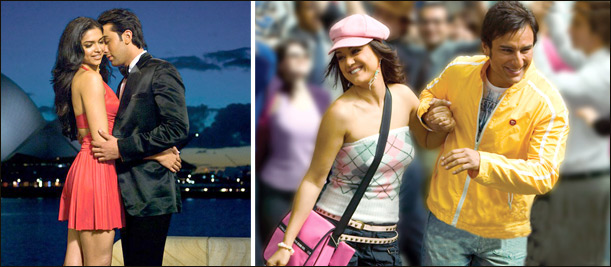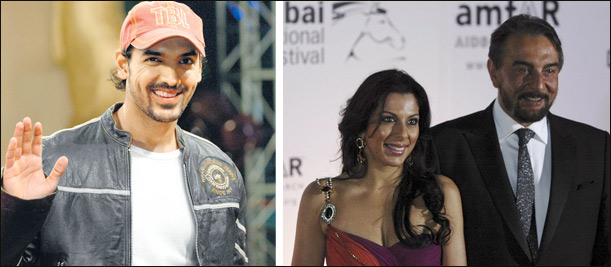|
|
| |
foreign
editorial
The Dubai-Mumbai Connection
No, we are not talking smuggling, but films. No, not controversies
involving underworld finance of the Mumbai film industry or extortion
money demands, but a rather more positive collaboration...
By Sharmistha
Gooptu |
| |
| The
names Mumbai and Dubai mentioned in a single breath still conjure
up a series of associations: an international grey market, Bollywood
nights, controversies involving underworld finance of the Mumbai film
industry and extortion money. It was not that long ago that the name
of Dubai was omnipresent in Mumbai's film world, before there emerged
a concerted move to legalize film finance and corporatize Hindi cinema.
|
| |
 |
| |
|
Now that corporatization seems to have become the
order of the day for the Mumbai film industry, the name of Dubai
is cropping up again, but in a very different context. This time
around, the links seem to be in tune to set up a rather more positive
connection.
It is well-known that Indian films have a regular market in West
Asia, both among the South Asian diaspora as well as the local population.
The Indian expatriate population in West Asia is one of the largest
in any part of the world, and the presence of this diaspora has,
over the years, worked to give Mumbai cinema a presence in local
society.
A professor of Middle-Eastern (as the Americans and Canadians call
West Asia) studies at the University of Toronto once mentioned that
Hindi films had been quite a part of his growing up years: it used
to be quite a social event when his family went to the movie theatre
to watch a 'Bollywood' film, though in those days, no one really
used the term Bollywood.
It appears that children of many upper class families in West Asia
are familiar with the world of Hindi films, courtesy their Indian
nannies, who are quite a brigade in these parts. In that sense,
however, West Asia at large has been no different from other parts
of the world where Hindi cinema has made for a niche culture, more
so in the contemporary age of a global 'Bollywood'. Where West Asia
has the potential to make a significant difference vis-à-vis
its already existing Bollywood link is in its latest investment
in a film culture which aspires to be both local and international,
and its aspiration to evolve as a contemporary cultural hub.
|
| |
 |
| |
| |
|
The Dubai Film Festival first organized in 2004
with a theme of 'Bridging Cultures Meeting Minds' best exemplifies
this blend of the global and local in the contemporary West Asia.
On the one hand, the festival has been geared towards the nurturing
of Arab cinema, on the other it aims to be a major international
event at par with similar international events across the world.
This mix of the global and local has a most culturally-proximate
repository in Bollywood/Hindi cinema. 'Bollywood' has now become
a global brand, ironically, for its song-and-dance prototype, which
was considered kitsch for many years in the past in relation to
the realist cinemas of the West, but is now increasingly being assessed
in terms of its unique aesthetic.
With West Asia, especially Dubai, looking to nurture a film culture
which is international, Mumbai can only be the next stop. Recently,
the Dubai-based Infinity Holdings signed a multi-million dollar
joint venture with Yash Raj Films for the creation of an entertainment
district in Dubai, which is now being considered a strategic location
by Bollywood corporates.
Not
only Dubai, other countries of West Asia should soon be increasingly
attractive to Bombay producers, given that West Asian governments
are now doing their best to promote film enterprise. Jordan immediately
comes to mind for being a country blessed with superb natural locations
offering a range of cinematographic possibilities. With the Jordanian
government working to build the country's film industry, Jordan
could easily start competing with Europe and Australia for a share
of Bollywood's foreign locations.
Many of Bollywood's leading production houses moved to Australia
in recent years in search of exotic shooting locations, and in a
bid to offset the costs of shooting in Europe or North America.
Yash Raj Films, which popularized the 'foreign' location in Bollywood
films through its almost patent Swiss locations (Yash Chopra has
a lake dedicated to him by the Swiss government for his role in
promoting Swiss tourism through his films) has increasingly begun
filming in Australia.
|
| |
 |
| |
|
Contemporary blockbusters, such as Dil Chahta Hai,
Salaam Namaste, Heyy Baby and Chak De India have been shot on Australian
locations. Like Australia, which threw up a range of new hot spots
for Hindi film producers, who used be somewhat fixated on Switzerland
and Europe, West Asia with its new initiatives in the field of film
enterprise, seems to be destined to be the next new destination
for Bollywood.
The added advantage for Hindi film industry vis-à-vis Dubai
or Jordan would be the relatively low cost of local crew and production
services in relation to Europe or Australia, as also a degree of
cultural affinity with the region. With Bollywood budgets sky-rocketing
in recent years in terms of star prices, technological innovation
and marketing, the industry would most certainly find it advantageous
to avail from international linkages closer to home with greater
potential for cost-effectiveness.
For Dubai or Jordan, a model could be Malaysia's new film city,
set up with the specific purpose of providing sophisticated production
and post-production facilities to Indian producers, for whom Malaysia
has been a favorite shooting location in the recent past. This includes
Hindi film producers, as well as the Tamil and Telegu language industries
of the South.
With its cultural proximity to large parts of South Asia, West Asia
figures as a leading contender in Bollywood's growing international
nexus. Both regions are a part of that configuration which may be
termed the "global south", and Mumbai and Dubai together
have a potential to crystallise industrial structures that may well
prove to be a viable counterpart to Hollywood.
India is one of the few countries in the world where Hollywood has
been unable to make a significant incursion vis-à-vis the
dominant Hindi and regional cinemas. On the other hand, Bollywood
of recent years has heightened its potential to reach global audiences
on the basis of increasingly sophisticated distribution and marketing
systems. This combination of 'local' culture and global potential
is what, at this point, aligns Mumbai with Dubai and West Asia in
general.
– Outlook India
|
|
|

